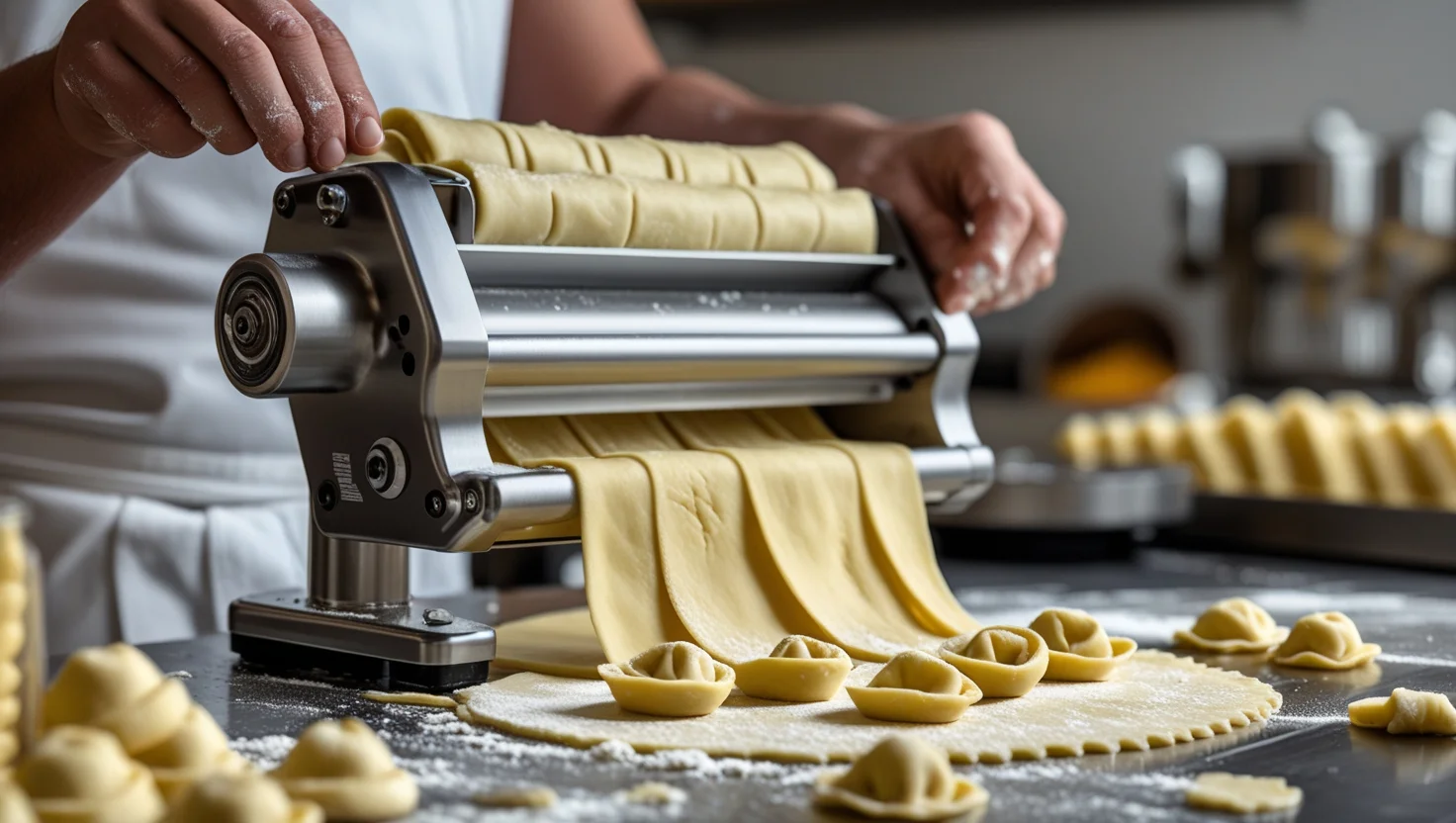Tortellinatrice: The Ultimate Guide to Traditional Italian Pasta Making Machines
The tortellinatrice represents one of the most fascinating innovations in Italian culinary tradition, embodying centuries of pasta-making expertise refined into a specialized machine. This remarkable device has transformed the art of creating perfect tortellini from a labor-intensive craft into an efficient yet authentic process that preserves the essence of traditional Italian cooking.
What is a Tortellinatrice?
A tortellinatrice is a specialized pasta-making machine designed specifically for creating tortellini, the iconic ring-shaped pasta from Italy’s Emilia-Romagna region. The name combines “tortellini” (the pasta shape) with the Italian suffix “-trice,” indicating a machine or device that performs a specific function. This ingenious apparatus automates the delicate process of shaping tortellini while maintaining the artisanal quality that makes this pasta so beloved worldwide.
Key Features of a Tortellinatrice
- Precision shaping mechanisms that create uniform tortellini rings
- Adjustable settings for different pasta thicknesses and sizes
- Durable construction typically made from stainless steel or food-grade materials
- Easy-to-clean components for maintaining hygiene standards
- Consistent output that ensures professional-quality results
Historical Origins and Evolution
The tortellinatrice embodies a rich tradition rooted in the art of pasta making. The journey from its historical origins to modern interpretations reveals how Italian ingenuity has continuously refined culinary tools to preserve authentic flavors while improving efficiency.
Traditional Beginnings
Tortellini creation traditionally required skilled hands and years of practice. Master pasta makers, known as sfogline, would roll thin sheets of pasta dough and carefully shape each individual tortellino by hand. This meticulous process could take hours to produce enough pasta for a single family meal.
Industrial Innovation
The development of the tortellinatrice emerged from the need to:
- Preserve authenticity while increasing production capacity
- Maintain consistency in shape and size
- Reduce labor intensity without compromising quality
- Meet growing demand for traditional Italian pasta
How a Tortellinatrice Works
Understanding the mechanics of a tortellinatrice helps appreciate the engineering marvel behind this specialized equipment.
The Shaping Process
| Step | Process | Result |
|---|---|---|
| 1 | Pasta sheet feeding | Continuous dough input |
| 2 | Filling dispensing | Precise filling placement |
| 3 | Cutting and shaping | Individual tortellini formation |
| 4 | Ring closure | Characteristic tortellini shape |
| 5 | Output collection | Ready-to-cook pasta |
Technical Components
The tortellinatrice consists of several crucial components working in harmony:
Feeding Mechanism
- Guides pasta sheets through the machine
- Ensures consistent thickness and alignment
- Prevents tearing or stretching of delicate dough
Filling Dispenser
- Controls precise amounts of filling
- Maintains consistent flavor distribution
- Prevents overfilling that could cause bursting
Shaping Dies
- Create the characteristic tortellini form
- Ensure proper sealing of pasta edges
- Maintain uniform size across production
Types of Tortellinatrice Machines
Modern tortellinatrice machines come in various configurations to suit different needs and production scales.
Manual Tortellinatrice
Perfect for home cooks and small-scale production:
- Hand-operated mechanisms
- Compact design suitable for home kitchens
- Affordable pricing for occasional use
- Easy storage when not in use
Semi-Automatic Models
Ideal for restaurants and medium-scale production:
- Electric motor assistance
- Higher production capacity
- Consistent output quality
- Professional-grade construction
Fully Automatic Industrial Units
Designed for commercial pasta production:
- High-volume output
- Minimal manual intervention
- Advanced control systems
- Integration with production lines
Benefits of Using a Tortellinatrice
Investing in a tortellinatrice offers numerous advantages for both home cooks and commercial establishments.
Time Efficiency
Traditional hand-shaping of tortellini can take several minutes per piece. A tortellinatrice dramatically reduces this time:
- Consistent production speed
- Reduced labor requirements
- Faster preparation for large quantities
- More time for other cooking preparations
Quality Consistency
Machine production ensures uniformity that’s difficult to achieve by hand:
- Identical pasta shapes
- Even filling distribution
- Consistent cooking times
- Professional presentation
Cost Effectiveness
Long-term savings through:
- Reduced labor costs
- Minimized waste
- Increased production capacity
- Consistent product quality
Choosing the Right Tortellinatrice
Selecting the appropriate tortellinatrice depends on several factors that align with your specific needs and circumstances.
Production Volume Considerations
- Home use: 50-100 pieces per hour
- Small restaurant: 200-500 pieces per hour
- Commercial production: 1000+ pieces per hour
Budget Factors
| Price Range | Features | Best For |
|---|---|---|
| Under $500 | Basic manual operation | Home enthusiasts |
| $500-$2000 | Semi-automatic features | Small restaurants |
| $2000+ | Full automation | Commercial operations |
Space Requirements
Consider available workspace:
- Counter-top models for limited space
- Floor-standing units for dedicated areas
- Integrated systems for production lines
Maintenance and Care
Proper maintenance ensures longevity and consistent performance of your tortellinatrice.
Daily Cleaning Routine
- Disassemble removable parts
- Clean with warm, soapy water
- Dry thoroughly to prevent rust
- Sanitize food-contact surfaces
Weekly Maintenance
- Lubricate moving parts as recommended
- Check for wear or damage
- Calibrate settings if necessary
- Deep clean hard-to-reach areas
Long-term Care
- Professional servicing annually
- Replace worn components promptly
- Store properly when not in use
- Follow manufacturer guidelines
Popular Tortellinatrice Brands and Models
Several manufacturers have established reputations for quality tortellinatrice production.
Italian Manufacturers
Leading the market with authentic designs:
- Imperia: Known for home-use models
- Marcato: Premium quality construction
- Arcobaleno: Professional-grade equipment
International Options
Global brands offering competitive alternatives:
- Various European manufacturers
- Asian production facilities
- North American distributors
Recipes and Applications
A tortellinatrice opens up numerous culinary possibilities beyond traditional tortellini.
Classic Tortellini Recipes
- Tortellini in Brodo: Traditional broth preparation
- Tortellini alla Panna: Creamy sauce variations
- Tortellini al Pomodoro: Tomato-based dishes
Creative Applications
- Seasonal filling variations
- Fusion cuisine adaptations
- Dietary-specific modifications
Troubleshooting Common Issues
Understanding common problems helps maintain optimal performance.
Pasta Tearing
- Check dough consistency
- Adjust machine settings
- Verify pasta sheet thickness
Inconsistent Shapes
- Calibrate shaping mechanisms
- Clean filling dispensers
- Check for worn components
Filling Distribution Problems
- Adjust dispenser settings
- Check filling consistency
- Clean blocked passages
Future of Tortellinatrice Technology
Innovation continues to enhance tortellinatrice capabilities:
- Smart technology integration
- Improved automation features
- Enhanced food safety systems
- Energy-efficient designs
Where to Buy and Pricing
Finding the right tortellinatrice requires research and comparison shopping.
Recommended Retailers
- Specialty kitchen equipment stores
- Italian culinary suppliers
- Online marketplaces
- Restaurant supply companies
For more information about traditional Italian cooking equipment and techniques, visit Beczema for comprehensive guides and expert recommendations.
Conclusion
The tortellinatrice represents the perfect marriage of traditional Italian craftsmanship and modern efficiency. Whether you’re a home cook passionate about authentic pasta or a commercial operation seeking consistent quality, investing in the right tortellinatrice can transform your approach to pasta making.
From its historical roots in Italian kitchens to its modern applications in restaurants worldwide, the tortellinatrice continues to evolve while preserving the essential character of handmade tortellini. By understanding the various types, features, and applications of these remarkable machines, you can make an informed decision that will enhance your culinary capabilities for years to come.
The art of pasta making need not be lost to time or compromised by mass production. With a quality tortellinatrice, you can maintain the authentic flavors and textures that make Italian cuisine so beloved while enjoying the efficiency and consistency that modern technology provides.







